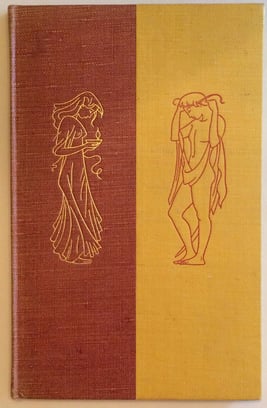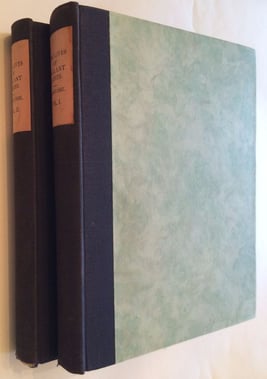Our love affair with fine press is no secret. And we’re in good company. Countless collectors and bibliophiles have discovered the art of fine press printing and savor the chance to compile libraries filled with these creative masterpieces. (If you’re new to fine press and would like to know more, start here!) The history of fine press is an interesting one, and we often focus on currently functioning fine presses. For example, we recently spotlighted a modern fine press printer, Two Ponds Press, which touts works like The Brownsville Boys and a Margaret Wise Brown original. Today, we’d like to look to a fine press publisher who thrived during the early part of the 20th century: The Golden Cockerel Press. Read on for interesting information about the history of this great press, some notable publications, and some necessary collector’s points.
 The Golden Cockerel Press was established in 1920 as a partnership between Hal Taylor, Bee Blackburn, Pran Pyper, and Ethelwynne Steward McDowell. In the early days of the press—even within the first year of its existence—it changed hands numerous times. Blackburn and Pyper relinquished their share of the partnership in 1921, and in 1924, Robert Gibbings purchased The Golden Cockerel. Gibbings, a renowned member of the Society of Wood Engravers, headed up the press and its efforts until the Great Depression, after which the Golden Cockerel changed hands again, this time being bought by Christopher Sandford. Sandford’s vision was to take the press from a private organization to a public publishing house. In doing so, Sandford published over 100 works before selling the press in 1959 to Thomas Yoseloff. Yoseloff shut down the press in 1961 due to cost and labor restraints.
The Golden Cockerel Press was established in 1920 as a partnership between Hal Taylor, Bee Blackburn, Pran Pyper, and Ethelwynne Steward McDowell. In the early days of the press—even within the first year of its existence—it changed hands numerous times. Blackburn and Pyper relinquished their share of the partnership in 1921, and in 1924, Robert Gibbings purchased The Golden Cockerel. Gibbings, a renowned member of the Society of Wood Engravers, headed up the press and its efforts until the Great Depression, after which the Golden Cockerel changed hands again, this time being bought by Christopher Sandford. Sandford’s vision was to take the press from a private organization to a public publishing house. In doing so, Sandford published over 100 works before selling the press in 1959 to Thomas Yoseloff. Yoseloff shut down the press in 1961 due to cost and labor restraints.
With a solid 40+ years of publication history, where should you begin when looking to collect works published by The Golden Cockerel Press?
It makes sense to start with some of the Press’s earliest publications. In 1921, The Golden Cockerel Press published first The Voices, a literary review, as well as Adam & Eve & Pinch Me, which was a collection of short stories by A.E. Coppard, a previously unknown author. Adam & Eve & Pinch Me was limited to 550 copies, according to a bibliography by Cave and Manson. Collectors can find one of these limited editions for $100-$200, depending on the book’s condition.
 The inaugural illustrated Golden Cockerel publication was The Wedding Songs of Spenser, published in 1923 and including color wood engravings by Ethelbert White. The edition was limited in number to 345. Wedding Songs set the standard for future Golden Cockerel books. The wood engravings in this edition, as well as those in later Golden Cockerel works, propelled the art form onward into the twentieth century. As such The Wedding Songs of Spenser is a fabulous collectible. A limited edition copy can cost collectors around $150, depending on the condition of the blue boards and canvas spine.
The inaugural illustrated Golden Cockerel publication was The Wedding Songs of Spenser, published in 1923 and including color wood engravings by Ethelbert White. The edition was limited in number to 345. Wedding Songs set the standard for future Golden Cockerel books. The wood engravings in this edition, as well as those in later Golden Cockerel works, propelled the art form onward into the twentieth century. As such The Wedding Songs of Spenser is a fabulous collectible. A limited edition copy can cost collectors around $150, depending on the condition of the blue boards and canvas spine.
Another early Golden Cockerel publication that’s worth noting is The Lives of Gallant Ladies. Published in 1924 in two volumes, The Lives of Gallant Ladies was limited to 625 copies and includes ten wood engravings by Robert Gibbings—at the time, the new owner of the Press. This is the first book Gibbings published at the helm of the organization, and the first to include his engravings. Interestingly, this book serves as an example of the transitions being undergone by The Golden Cockerel Press as a whole. The binding and layout is similar to older Cockerel editions; however, the engravings and other details are proof of the direction the Press was moving. These limited edition copies will cost a collector between $100-$150.
 Moving into the latter years of The Golden Cockerel Press, we’d recommend looking into Laus Veneris (photo at left) by Algernon Charles Swinburne with engravings by John Buckland-Wright (1948). Likewise, Hero & Leander, the Greek Myth and tragic love tale by Musaeus (1949) is another beautiful edition.
Moving into the latter years of The Golden Cockerel Press, we’d recommend looking into Laus Veneris (photo at left) by Algernon Charles Swinburne with engravings by John Buckland-Wright (1948). Likewise, Hero & Leander, the Greek Myth and tragic love tale by Musaeus (1949) is another beautiful edition.
For those who are interested in building a Shakespeare collection, The Golden Cockerel Press published Twelfth Night in 1932 with 29 wood engravings by Eric Ravillious. These editions were limited in number to 275, and are valuable collectibles with prices stretching toward $5,000. In 1960, just a year before the Press shut down, it published The Poems and Sonnets by Shakespeare and edited by Gwyn Jones. Fine copies can cost around $2,000.
Finally, the crowning jewels of the Press are considered to be the Canterbury Tales (1929-1931) and Troilus and Criseyde (1927) by Geoffrey Chaucer and Four Gospels (1931). These books were all limited in number and can cost several thousand dollars. Eric Gill completed wood engravings for each of these works, and he was a groundbreaker in his day (albeit quite controversial now), establishing typeface specifically for the Press as well as commissioning noteworthy engravers of the time.
Source here.









